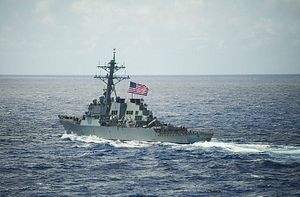As The Diplomat previously reported, the United States has conducted a second freedom of navigation operation (FONOP) within 12 nautical miles of a disputed island in the South China Sea. On January 30, the USS Curtis Wilbur, a guided-missile destroyer, sailed within 12 nautical miles of Triton Island in the Paracels, which is controlled by China but also claimed by Vietnam and Taiwan. This particular FONOP was designed to assert the right of innocent passage through territorial waters without having to give advance notice (something both China and Vietnam demand when foreign vessels transit through territorial waters in the Paracels.
China’s Foreign Ministry responded sternly to the FONOP, saying that “the U.S. navy vessel violated the relevant Chinese law and entered China’s territorial sea without authorization.” As spokesperson Hua Chunying explained, “According to the Law of the People’s Republic of China on the Territorial Sea and the Contiguous Zone, foreign ships for military purposes shall be subject to approval by the Government of the People’s Republic of China for entering the territorial sea of the People’s Republic of China.”
It’s precisely this law requiring prior approval, even for innocent passage, that the U.S. FONOP was designed to counter. As U.S. Secretary of Defense Ashton Carter said in a statement:
This operation challenged attempts by the three claimants, China, Taiwan and Vietnam, to restrict navigation rights and freedoms around the features they claim by policies that require prior permission or notification of transit within territorial seas. The excessive claims regarding Triton Island are inconsistent with international law as reflected in the Law of the Sea Convention.
On Monday, Foreign Ministry spokesperson Lu Kang rejected that explanation, claiming that the “so-called” FONOP “is conducted in disregard of sovereign security and maritime rights and interests of coastal states, causing severe damage to regional peace and stability.”
“It is, in essence, the pursuit of maritime hegemony by the U.S. under the cloak of ‘freedom of navigation,’” Lu added, calling “the flexing of military muscles and creating of tension by the U.S. under the pretext of the freedom of navigation is the biggest cause of militarization in the South China Sea.”
Lu also said that Chinese troops, “naval ships and airplanes made an immediate response” to the Curtis Wilbur’s presence. However, a Pentagon spokesperson said that no Chinese naval vessels had escorted the Curtis Wilbur during the mission, unlike during the USS Lassen’s FONOP near Subi Reef last October.
Vietnam, meanwhile, responded by saying that it respects the right to innocent passage through its territorial waters in accordance with international law. Foreign Ministry spokesperson Le Hai Binh also reiterated Vietnam’s “indisputable sovereignty over Hoang Sa [Paracel] as well as Truong Sa [Spratly] archipelagoes.”
Though the USS Lassen’s patrol near Subi Reef in October and the USS Curtis Wilbur’s transit near Triton Island are both categorized as FONOPs, the legal rationale behind each was quite different. The USS Lassen passed within 12 nautical miles of Subi Reef, which has been artificially enlarged by China, to demonstrate the United States’ belief that the feature is still legally considered a low-tide elevation, not an island.
Accordingly, China’s official response was angry but also intentionally vague – China, in effect, scolded the United States from breaching the 12 nautical mile zone around Subi without explicitly claiming that Subi is, in fact, entitled to a territorial sea (see Graham Webster’s detailed parsing of the language that was used).
By contrast, the FONOP around Triton is more clear-cut – China does explicitly claim a territorial sea around the Paracels. The U.S. FONOP in the area was designed to counter two aspects of China (and Vietnam’s) claims: the requirement for foreign warships to seek prior authorization before transiting near the feature, and the way territorial baselines are drawn around the Paracels. As James Kraska of the Naval War College explained to USNI, “China has established unlawful straight baselines around all the [Paracel] islands — which is illegal.”
This FONOP is more straightforward because it’s clear precisely what is being claimed – and that the United States rejects those claims as “excessive” and “inconsistent with international law.” It’s potentially more destabilizing for the same reason – unlike at Subi Reef, China has clearly claimed a territorial sea around the Paracels, and thus could react more strongly to a perceived U.S. incursion (although as of yet, there’s no indication China will up the ante).
The transit by the USS Curtis Wilbur will not be the end of U.S. FONOPs in the region. Admiral Harry B. Harris, the commander of U.S. Pacific Command, recently told a Washington, D.C. audience that “as we continue down the path of freedom of navigations, you will see more of them, and you will see them increasing in complexity and scope in areas of challenge.”

































